|

Weight: The weight of a female varies between 60 and 170 kg. In some subspecies of reindeer, the male is slightly larger; in others, the male can weigh up to 300 kg.
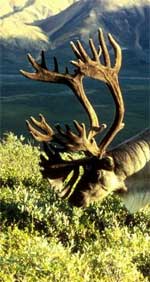 Antlers: Both sexes grow antlers, which (in the Scandinavian variety) for old males fall off in December, for young males in the spring and for females during the summer. The antlers typically have two separate groups of points, a lower and upper. Antlers: Both sexes grow antlers, which (in the Scandinavian variety) for old males fall off in December, for young males in the spring and for females during the summer. The antlers typically have two separate groups of points, a lower and upper.
Domesticated animals (reindeer) are shorter-legged and heavier than their wild counterparts (caribou). The caribou of North America can run at speeds of almost 50 miles per hour and may travel 3,000 miles in a year.
Diet: Reindeer are ruminants, having a four-chambered stomach. They mainly eat lichens in winter, especially reindeer moss. However, they also eat the leaves of willows and birches, as well as sedges and grasses. They can also eat voles (lat. Clethrionomys glareolus), lemmings (lat. Lemmus lemmus), birds and bird eggs.
Antler Regrowth: Reindeer antlers grow again each year under a layer of fur called velvet.
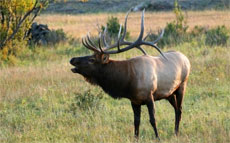 Noses: Reindeer have specialized noses featuring nasal turbinate bones that dramatically increase the surface area within the nostrils. Incoming cold air is warmed by the animal's body heat Noses: Reindeer have specialized noses featuring nasal turbinate bones that dramatically increase the surface area within the nostrils. Incoming cold air is warmed by the animal's body heat
before entering the lungs, and water is condensed from the expired air and captured before the deer's breath is exhaled, used to moisten dry incoming air and possibly absorbed into the blood through the mucous membranes.
Hooves: Reindeer hooves adapt to the season: in the summer, when the tundra is soft and wet, the footpads become spongy and provide extra traction. In the winter, the pads shrink and tighten, exposing the rim of the hoof which cuts into the ice and crusted snow to keep the animal from slipping.
Possible Advertisement
Coat: The reindeer coat has two layers of fur, a dense woolly undercoat and longer-haired overcoat consisting of hollow, air-filled hairs. A caribou or reindeer swims easily and fast; migrating herds will not hesitate to swim across a large lake or broad river.

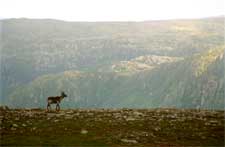 Distribution:The reindeer is distributed throughout a number of northern locales. Reindeer are found throughout Scandinavia (including Iceland); in Finland; at Spitsbergen; in Russian Europe including Northern Russia and Novaya Zemlya; in Russian Asia, to the Pacific Ocean; in North America on Greenland, Canada and Alaska. In 1952 reindeer were re-introduced to Scotland, as the natural stock had become extinct in the 10th century. Distribution:The reindeer is distributed throughout a number of northern locales. Reindeer are found throughout Scandinavia (including Iceland); in Finland; at Spitsbergen; in Russian Europe including Northern Russia and Novaya Zemlya; in Russian Asia, to the Pacific Ocean; in North America on Greenland, Canada and Alaska. In 1952 reindeer were re-introduced to Scotland, as the natural stock had become extinct in the 10th century.
Domesticated reindeer are mostly found in Northern Scandinavia and Russia, and wild reindeer are mostly found in North America, Greenland and Iceland (introduced by humans in the 18th century). The last wild reindeer in Europe are found in habitats in southern Norway. Its natural occurrence is approximately bounded within the 62° latitude.
Migration: In the wild, most caribou migrate in large herds between their birthing habitat and their winter habitat. Their wide hooves help the animals move through snow and tundra; they also help propel the animal when it swims. About 1 million live in Alaska, and a comparable number live in northern Canada.
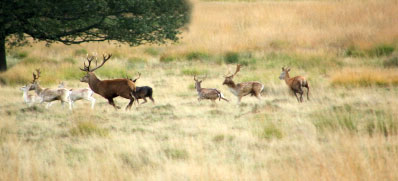
Eurasia: There are an estimated 5 million reindeer in Eurasia, mainly semi-domesticated. The last remaining European herds of the genetic wild reindeer are found in central Norway, mainly in the mountainous areas of Rondane, Hardangervidda, Dovre and Forollhogna. Other areas, such as Filefjell, have populations of reindeer that have been herded in the past but are now left free. Wild reindeer are considered to be very vulnerable to human disturbance, especially during the calving period in April.
Social Behavior: Males usually split apart from the group and become solitary, while the remaining herd consists mostly of females, usually a matriarchy.
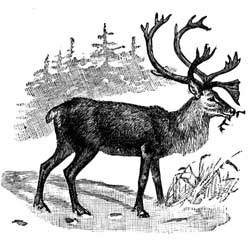 Natural threats: Natural threats to caribou include avalanches and predators such as wolves, wolverines, lynxes, and bears. Humans started hunting reindeer in the Mesolithic and Neolithic periods. Ravens can indirectly kill caribou calves by blinding them (eating their eyes). Parasites include warble flies, mosquitoes, and nose bot flies. Roundworms and tapeworms can also afflict reindeer. Natural threats: Natural threats to caribou include avalanches and predators such as wolves, wolverines, lynxes, and bears. Humans started hunting reindeer in the Mesolithic and Neolithic periods. Ravens can indirectly kill caribou calves by blinding them (eating their eyes). Parasites include warble flies, mosquitoes, and nose bot flies. Roundworms and tapeworms can also afflict reindeer.
Diseases: Diseases include brucellosis, foot rot, and keratitis (white-eye, an infection of the eye).
Herded By: Reindeer have been herded for centuries by the Sami people of Lapland. They are raised for their meat, hides and antlers, and (especially formerly) also for milk and transportation. Reindeer are not considered fully domesticated, as they generally roam free on pasture grounds. In traditional nomadic herding reindeer herders migrated with their herds between coast and inland areas according to an annual migration route, and herds were keenly tended. However, reindeer have never been bred in captivity, though they were tamed for milking as well as for use as draught animals or beasts ofburden.
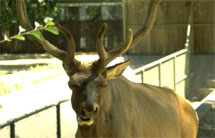 Reindeer As Livestock: The use of reindeer as semi-domesticated livestock in Alaska was introduced in the late 1800s by Sheldon Jackson as a means of providing a livelihood for Native peoples there. A regular mail run in Wales, Alaska used a sleigh drawn by reindeer. In Alaska, reindeer herders use satellite telemetry to track their herds, using online maps and databases to chart the herd's progress. Reindeer As Livestock: The use of reindeer as semi-domesticated livestock in Alaska was introduced in the late 1800s by Sheldon Jackson as a means of providing a livelihood for Native peoples there. A regular mail run in Wales, Alaska used a sleigh drawn by reindeer. In Alaska, reindeer herders use satellite telemetry to track their herds, using online maps and databases to chart the herd's progress.
Caribou Hunting: Wild caribou are still hunted in North America. In the traditional lifestyle of the Inuit people, Northern First Nations people, and Alaska Natives the caribou is a source of food, clothing, shelter and tools.
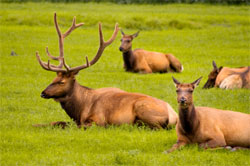 Economic Role: The reindeer has (or has had) an important economic role for all circumpolar peoples, including the Sami, Nenets, Khants, Evenks, Yukaghirs, Chukchi and Koryaks in Eurasia. It is believed that domestication started between Bronze Age-Iron Age. Siberian deer-owners also use the reindeer to ride on. (Siberian reindeer are larger than their Scandinavian relatives.) For breeders, a single deer-owner usually own some hundreds or up to thousands of animals. The numbers of Russian herders have been drastically reduced since the fall of the Soviet Union. The fur and meat is sold, which is an important source of income. Reindeer were introduced into Alaska near the end of the 19th century; they interbreed with native caribou subspecies there. Reindeer herders on the Seward Peninsula have experienced significant losses to their herds from animals following the wild caribou during their migrations. Economic Role: The reindeer has (or has had) an important economic role for all circumpolar peoples, including the Sami, Nenets, Khants, Evenks, Yukaghirs, Chukchi and Koryaks in Eurasia. It is believed that domestication started between Bronze Age-Iron Age. Siberian deer-owners also use the reindeer to ride on. (Siberian reindeer are larger than their Scandinavian relatives.) For breeders, a single deer-owner usually own some hundreds or up to thousands of animals. The numbers of Russian herders have been drastically reduced since the fall of the Soviet Union. The fur and meat is sold, which is an important source of income. Reindeer were introduced into Alaska near the end of the 19th century; they interbreed with native caribou subspecies there. Reindeer herders on the Seward Peninsula have experienced significant losses to their herds from animals following the wild caribou during their migrations.
Reindeer Meat: Reindeer meat is popular in the Scandinavian countries. Reindeer meatballs are sold canned. Reindeer stew is the best-known dish in Lapland. In Alaska, reindeer sausage is sold locally to supermarkets and grocery stores.
Reindeer antler is powdered and sold as a nutritional or medicinal supplement to Asian markets.
All text is available under the terms
of the GNU Free Documentation License
|